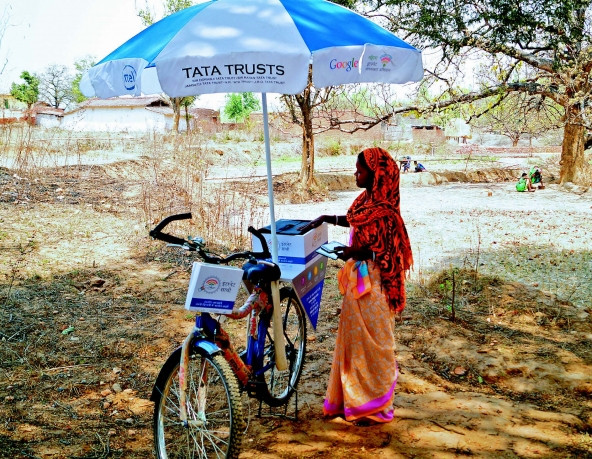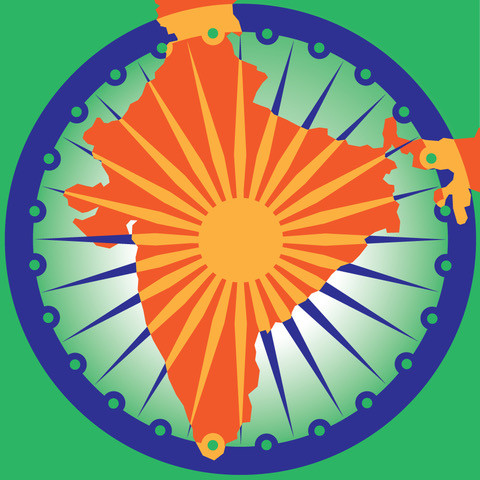 A Saathi prepares to provide Internet access to villagers in the Deoghar district in Jharkhand state. (Photo courtesy of Clnl - Tata Trusts)
A Saathi prepares to provide Internet access to villagers in the Deoghar district in Jharkhand state. (Photo courtesy of Clnl - Tata Trusts)

Maniben Roz, a 38-year-old mother and farmer who lives in the western Indian state of Gujarat, raises cattle. Although she’s been doing it for more than a decade, she had no idea that for most of that time, she had been taking care of her cattle improperly. Then she was introduced to a Saathi (Hindi for “friend”)—a woman helping Google to bring Internet capabilities to India’s rural areas. “Earlier I used to put feeding straw near the cattle without noticing the dung and hygiene of the place,” Roz says. “During an interaction with the Saathi, we saw videos of how to rear cattle and searched the proper way of feeding.”
Now Roz is feeding her cattle the right amount of straw, cutting it up for easy consumption and keeping it far from their dung. “This has been a learning to me, and I look forward to getting more information regarding daily routine,” she says. Though illiterate, Roz is part of a growing group of women who, through the Saathi program (formally called Helping Women Get Online, or HWGO), are learning how to use the Internet for the first time in their lives.
A Clear and Great Need
According to the Pew Research Center, just 22 percent of Indian adults have access to the Internet; compare that with China’s 65 percent Internet penetration level and Brazil’s 60 percent. And for Indian women, the numbers are even worse: Just 17 percent of Indian women are online. Neha Barjatya, who runs Digital Initiatives at Google India, says that rural women, in particular, are excluded; only 1 in 10 Internet users in rural India is a woman. Women in India, she says, are held back from using the Internet for a host of cultural reasons. For example, in India the Internet is seen as men’s domain, a tool primarily for work. In addition, many Indian women don’t feel that it is relevant to their day-today lives. And many women in India are illiterate, making it difficult for them to use the Internet.
That’s why in 2013, Google launched HWGO, an effort to make women throughout India more Internet-savvy. HWGO created a website where women could find relevant content in four major languages, Hindi, Marathi, Tamil, and English. It also created a toll-free phone number providing technical help to women logging on to the Web. That initial campaign saw notable success, reaching more than 1.5 million women in five states.
In urban India, HWGO thrived—in large part through cyber cafés that offered a welcoming environment where women could go online. But reaching women in rural India was a challenge, says Barjatya. So Google launched a pilot in Bhilwara, Rajasthan. It was based around a simple concept: mobile Internet carts. These kiosks-on-wheels were operated by a trained local resident, male or female, equipped with a tablet or smartphone who would perform search and answer queries for women.
Bicycles Go Farther Than Carts
With the mobile carts, women could queue up to use the Internet, and they did. With the support of corporations—including Intel, Unilever, and Samsung—the program grew, soon reaching 500,000 women. But the program still had some limitations. Even though the carts were mobile, they couldn’t reach all of the places they needed to. So in 2015 Google rolled out a bicycle-based approach: a trained, Internet-savvy woman bicycles to nearby villages with a tablet and smartphone. She teaches other women how to use the technology and also goes online to find answers to their immediate questions: when to immunize a child, how to get a loan for education. They search for the answers together on the Android smartphone and tablet, provided by Google. Since this program involved local women in the villages helping each other to get online, its adopted name soon became Internet Saathi.
To reach India’s interior, Google partnered with Tata Trusts, the charitable arm of the Tata Group, which has been working on community-level development projects for the last 30 years. Google provided the Android hardware and paid for data packages to access the Internet. Tata Trusts organized the bicycles and individual trainers. “It’s 60 percent Google and 40 percent Tata Trusts,” says Ganesh Neelam, head of Internet Saathi for Tata Trusts.
The bicycle, Neelam says, has been the ideal vehicle. Bicycles are easier for one person to navigate and can make their way through narrow alleys in rural areas. Plus, the Saathis can keep the bicycles at home and use them at their convenience. Compared with the carts, bicycles are also less expensive and easier to maintain.
The bicycle-based program has grown through 2016, reaching women in nine states across India: Rajasthan, Gujarat, Jharkhand, Andhra Pradesh, Madhya Pradesh, West Bengal, Uttar Pradesh, Bihar, and Assam. To date, Saathis have worked in 18,500 villages, reaching more than 300,000 women. The goal is to hit 105,000 villages by March 2017.
Challenges to Growth
Despite the growing number of beneficiaries that attest to Internet Saathi’s success, Neelam says, Google has had to confront two major hurdles in growing the program: First, in many locations, Saathis have faced resistance from their families. Wanting to keep their women at home, or at least nearby, parents and husbands have been hesitant to let them cycle to neighboring villages and take on this leadership role. (A very small number of Saathis are men, who do not face this problem.) Second, there is the problem of literacy: varying levels of literacy in communities have made it hard for Saathis to roll out one-size-fits-all approaches to training their clients.
To address the first hurdle, Tata Trusts has worked with local self-help groups to help families understand the work of a Saathi. “Some families were able to realize this on their own, and are now highly supportive of their daughters, or wives, to work as an Internet Saathi,” says Neelam.
The second hurdle, low literacy levels, is being resolved through technology. Voice searches on the smartphones are enabling women to ask questions in their local language. In fact, Barjatya says, when women must work more closely with a Saathi who is literate to get the answers to their questions, that interaction builds camaraderie and strengthens the program: “There’s a sense of community sharing with literate women helping the illiterate ones.”
Even with the cultural issues addressed, some technical challenges remain. For one, there’s a lack of high-speed connectivity across rural India. Couple that with high data costs throughout the country; even with a free smartphone, the cost of running the program and the cost for rural women to use data is high.
In addition, Barjayta worries that as the program grows, ensuring that it works effectively will become more difficult. “As we scale, ground implementation will get more challenging in terms of execution and managing the Saathis across thousands of villages, including in remote areas,” she says.
Scaling Up
Neha Kumar, a professor at the Georgia Institute of Technology’s School of International Affairs, welcomes Google’s efforts. She spoke with Google as it was formulating the HWGO program, and she says that their research was exhaustive and well done. But Kumar is also wary of a few of the program’s details. She notes that Google has focused on a curated selection of articles for women, mostly pertaining to housekeeping, personal health, and cooking. This content, says Kumar, is “reinforcing prevalent gender stereotypes.”
Responding to those concerns, Barjatya notes that village women are actively using the Internet to find information and services to help improve their lives. This content spans across education, health, farming, job opportunities, and new skills. For example, Raja Beti, a 22-year-old housewife in Dholpur, searched for new recipes online and found a YouTube video on how to cook noodles. She opened a chow mein stand and is now earning an income.
Kumar has also raised the question of sustainability. Though the program may reach hundreds of thousands if not millions of women, she wonders whether it can be sustained if data costs are high and if smartphones and computers continue to be difficult to acquire in rural India. Neelam says that Tata Trusts and Google are looking at ways to help the Saathis become entrepreneurs, by providing Internet-based services to the community in a way that generates revenue. For example, they could charge a nominal fee to help people who are illiterate to access and understand existing government services designed to provide help with health care, access to food, and even financing.
Support SSIR’s coverage of cross-sector solutions to global challenges.
Help us further the reach of innovative ideas. Donate today.
Read more stories by Esha Chhabra.

